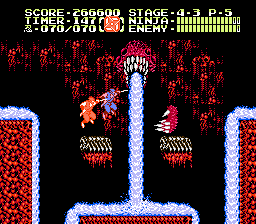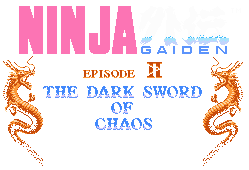 ... ...
I still remember the day I got Ninja Gaiden 2. I had bought it simultaneously with NES Shadowgate with money I had both saved and gotten for my birthday. Since I was, and still am, a huge fan of the original NES Ninja Gaiden, I was very, very excited to get the sequel. I had read about it in Nintendo Power, and even owned the NP Strategy Guide for it, all of which had me really hyped up for it.
As far as Ninja Gaiden games go, NG2 certainly didn't disappoint me, but it wasn't quite as good as the first one. Once again, you are in the role of Ryu Hayabusa, as he flips and slashes his way through countless foes from the Realm of Chaos. The gameplay is nearly identical to that of NG1, with only a few minor twists and tweaks.
GRAPHICS:
9/10The graphics of Ninja Gaiden 2 are a slight step up over the original. They are not quite as grainy and, overall, are more detailed and colorful. There are also many more special effects present, such as parallax scrolling on a train ride, lightning flashes that illuminate an otherwise darkened level, and clouds that drift in the background during a boss fight. I don't recall any level of NG1 that had animation in the background, but NG2 is home to swirling flames, flowing blue rivers, and, my personal favorite, a level with beating hearts embedded in the walls.
I've always thought the Ninja Gaiden series has an interesting art style. I like how the levels are carved out of an overall picture. Instead of having obvious blocks and platforms that hang in midair, like many sidescrolling platformers do, almost every object in Ninja Gaiden that you can interact with somehow corresponds to the background. This technique is perhaps even more effective in Ninja Gaiden 2 than in NG1. One of my most infamous memories of NG1 is the first level, which is supposed to look like the average American city, but has a ridiculous amount of Coca-Cola signs and buildings that all look alike. At the end of this level, you end up in jail, and escape into what appears to be the Grand Canyon. This made me wonder if Ninja Gaiden's designers had never been to America and this is what they imagined it was like. The locational continuity in NG2 is a bit more realistic. Now, the first level is actually passable for a real city.
The cinema scenes are dazzling as always, and they are perhaps even more detailed than those of NG1. One of the most fantastic and well-known cinemas from Ninja Gaiden was that of Ryu standing atop a cliff, looking across at the immese Temple of Darkness. Ninja Gaiden 2 gives us not one, but two scenes like this, and are they are at least as splendid, if not more.
 ... ...
SOUND:
8.5/10It seems like the debate of Ninja Gaiden's Music vs. Ninja Gaiden 2's music is an argument that's never really going to be decided, but for all intents and purposes, I like Ninja Gaiden 2's music slightly more than the first one's. The melodies are stronger and stand out to me more. The percussion sounds particularly good. "The Parasprinter", which is first heard inside the Tower of Lahja (Level 3-2), is my favorite song from the Ninja Gaiden series thus far. Ninja Gaiden 2 also features the awsome "Lord of Night" boss theme. The sound effects are almost identical to NG1's effects.
STORY/ATMOSPHERE:
7.5/10Up to this point, Ninja Gaiden 2's aesthetics have equalled or surpassed its predecessor, but the story is where it takes a bit of a dive. We are introduced to a new villain, an evil samurai-like warrior named Ashtar, who claims to be the Emperor of Darkness. He carries a mysterious blade known as the Sword of Chaos, which is the complete antithesis of Ryu's Dragon Sword. Ashtar kidnaps Irene Lew, the woman that Ryu met in the first adventure, and much of the story is one big wild goose chase through the Maze of Darkness as you try to track down Ashtar and stop his evil schemes.
This story doesn't have the development or the surprise twists of the original Ninja Gaiden, but in many ways, is just as effective. Even though I was aware of who the "true" villain was long before I ever played this game, I was still a little freaked out by his appearance. (The scene where two main characters first encounter this entity reminded me of the scene in the movie Aliens where Ripley meets the Alien Queen.)
Ninja Gaiden 2 also has, quite possibly, the darkest and most brooding atmosphere of any NES game I've yet played. The artistic style definitely plays a big factor in this: The Maze of Darkness with all of its melting skulls and webbed walls is one of the eeriest places I've ever been to in a game. The story also has an incredible climax, which at first, left me not knowing exactly what happened. This could be partially due to unclear translation, but it's also likely that the writers wanted to leave some things up for you to draw your own conclusions about. But it did make me rethink the origins of the "Demon" from the first Ninja Gaiden.
 ... ...
CONTROL:
9/10The play control of Ninja Gaiden was very quick and precise, which added to the fun factor, and it is nearly duplicated here in the sequel. There is only one major difference: Ryu can now climb walls, even those without a ladder attached to them. In the original Ninja Gaiden, Ryu could only ascend some vertical surfaces by jumping between two objects and bouncing back and forth, "triangle-jump" style. While that did give Ninja Gaiden an extra edge and a bit of uniqueness among platform games, I don't think the absence of it in NG2 affected my enjoyment. I can live with it having it either way.
Instead of wall-spring jumps, Ninja Gaiden 2 has the unusual feature of "phantom doubles", an idea most likely gotten from IREM's Ninja Spirit. These are two invincible "shadows" of Ryu that follow behind him and mimic his every move. They swing their swords as you swing your sword, but their actual running and jumping is delayed several frames, so they don't jump exactly when you do. Therefore, you could theoretically jump up and strike an enemy (such as a boss), then move away, and your shadow double(s) will mimic that and end up in position to attack the enemy as you run to a safe spot. Mastering the use of these phantoms is a bit tricky, and it's not really even necessary, but they can make some boss fights a bit easier when utilized properly.
CHALLENGE:
7.5/10The challenge of Ninja Gaiden 2 is also a step down from NG1. The difficulty curve essentially remains the same: The game is actually rather easy for most of the early levels. You can "Rambo" your way through them and not have much trouble. But on the final few levels, the challenge picks up significantly. Ninja Gaiden 2, once again, culminates in a three-boss-in-a-row showdown, in which defeat sets you back at the very beginning of the last level. There is nothing, however, that matches the difficulty and artistic genius of Level 6 in Ninja Gaiden.
Even though the basic gameplay of Ninja Gaiden 2 remains essentially the same as NG1, a few new gimmicks are thrown at you. In one level, the wind constantly changes direction, sometimes blowing you forwards or backwards, making it difficult to scale the mountain ahead and make jumps over bottomless pits. Another level is obscured by darkness, and the way forward is marred with pits. Safe spots only become momentarily visible when sporadic lightning bolts flash and illuminate the background. Slippery ice and waterfalls make the going tough in other stages.
One aspect of Ninja Gaiden 2 that might be somewhat superior to NG1 is its boss battles. Most of NG1's bosses could be beaten by standing in one spot and swinging your sword over and over again. (This was true of almost all of them up to the last three.) NG2's bosses definitely force you to move around and use more strategy. However, they still aren't all that challenging and they don't quite rank up there with the best boss battles in game history. The final three bosses, which can be tough until you figure out their patterns, are still not quite as difficult as NG1's final three bosses.
FUN:
8.5/10I won't deny that Ninja Gaiden 2 is a lot of fun to play. The excellent play control coupled with the fast action and decent level designs are what make both Ninja Gaiden 1 and 2 very enjoyable. A lot of fun also comes from memorizing enemy patterns and learning to deal with obstacles that stunt your progression. It's just somewhat disappointing that, for all the new elements NG2 possesses, it couldn't quite take the Ninja Gaiden series to a new level. It feels like an extension of NG1, whereas it could've been more like a second, tougher quest. It is more like what Super C is to Contra than what The Lost Levels is to Super Mario Bros. In some cases, it didn't even seem like the ideas the designers had were implemented very well. For example, there is one area where spikes cover the walls and ceilings, but most of them are positioned in such a way that you're not very likely to run into them, so they pose little threat.
One decision I can agree with was the removal of the "Jump n Slash" technique. I remember Nintendo Power almost made it sound disappointing that this special move was omitted, but I felt "Jump n Slash" made it too easy to cheese some bosses and areas in NG1. Ninja Gaiden 2 certainly doesn't need anything to make it any easier.
 ... ...
It's a shame that Ninja Gaiden 2 couldn't do for the Ninja Gaiden series what Castlevania 3 did for the Castlevania series. But it's still a solid, decent platformer that is very fun to play. It also looks and sounds beautiful. If you're someone who has never played a Ninja Gaiden game, you may not have found this review to be much help, since it's been mostly a comparison between Ninja Gaiden 1 and 2. My suggestion would be to try Ninja Gaiden 1 first, and if you like it, you can find more of the same good stuff in Ninja Gaiden 2, even if it's not quite on par.
OVERALL
SCORE (not an average): 8/10
BACK TO NES
REVIEWS
BACK TO MAIN
PAGE |
|



